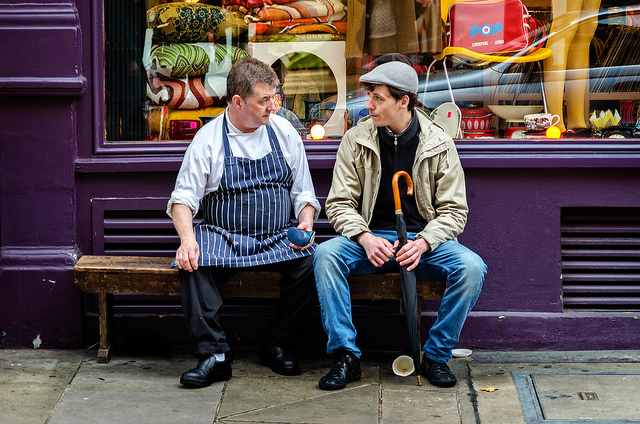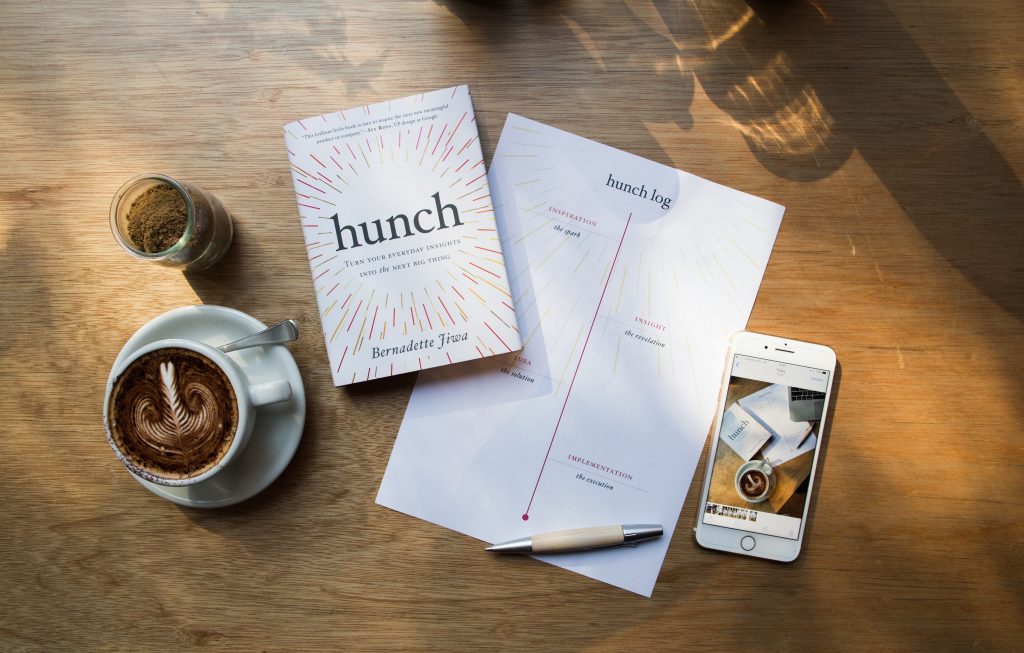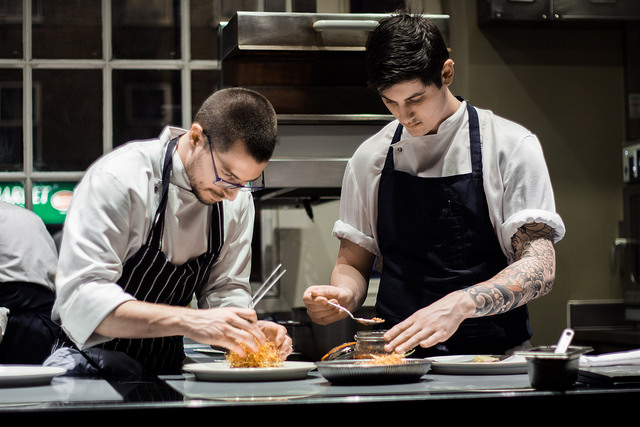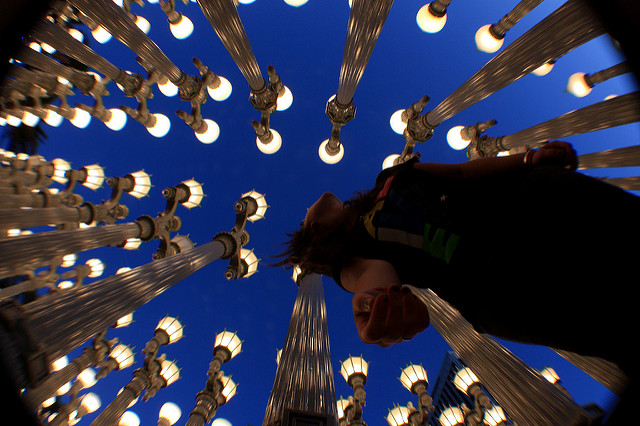Unlock the Magic in Your Story Now
Get the Free 20 questions to Ask Before Launching Your Idea workbook when you sign up for occasional updates.
Get the Free 20 questions to Ask Before Launching Your Idea workbook when you sign up for occasional updates.
Articles filed in: Innovation
The Two Questions Behind Every Successful Product And Service
filed in Innovation, Marketing, Strategy
 There’s a subtle difference between a product or service that stems from an idea and one that’s born from recognising an opportunity. Ideas are solutions in search of problems. Opportunities are problems begging for a solution. The magic of solving problems for a specific customer is that the marketing is baked into the product.
There’s a subtle difference between a product or service that stems from an idea and one that’s born from recognising an opportunity. Ideas are solutions in search of problems. Opportunities are problems begging for a solution. The magic of solving problems for a specific customer is that the marketing is baked into the product.
Like many disruptive companies, the team at Dollar Shave Club created a compelling product, innovative business model and viral marketing campaign simply by understanding their customer’s pain points.
We find opportunities when we look for problems to solve, by asking the following two questions:
1. What’s happening that shouldn’t be?
2. What’s not happening, that should be?
In the case of Dollar Shave Club, the answers were clear. The razor blade market was dominated by a few legacy brands who had no direct relationship with their customers. Men were paying a lot of money for shave tech they didn’t need. Buying expensive razor blades didn’t necessarily guarantee a better shaving experience. Shopping for razors and replacing blades wasn’t as convenient as it could be. The startup disrupted the market by addressing these unmet needs.
The utility, quality and success of our products and services improve when we pay attention to what’s missing in our customers’ lives.
What gaps can you fill for your customers?
[Learn more about turning your insights into successful products and services in my new book, Hunch].
Image by Thomas Hawk.
You Know More Than You Think
filed in Innovation, Strategy
 We could be forgiven for thinking that facts and figures communicate the whole truth and hold the keys to unlocking the value in every future opportunity. New digital tools and technologies not only give us more information about the world around us and the people in it but also help us to know more about ourselves. We can literally monitor every step we take and every calorie we consume. The great hope is that if we can gather enough data, we will have the power to change the things we want to change—and that we can do it without having to face the fear of uncertainty.
We could be forgiven for thinking that facts and figures communicate the whole truth and hold the keys to unlocking the value in every future opportunity. New digital tools and technologies not only give us more information about the world around us and the people in it but also help us to know more about ourselves. We can literally monitor every step we take and every calorie we consume. The great hope is that if we can gather enough data, we will have the power to change the things we want to change—and that we can do it without having to face the fear of uncertainty.
Data—that which we can easily measure—is supposed to make us smarter, and maybe it can, but I’d argue that it doesn’t always make us wiser. Many of our actions and reactions can be observed and quantified, but that data doesn’t always expose the truth about why we take or have them. If it did, we would have found a way to stop people smoking cigarettes, overeating, gambling and drinking to excess. All of the health data that scientists use to persuade us to change our behaviour doesn’t necessarily have any effect. Hard facts tell only part of the story.
The Power Of Intuition In A Data-Driven World
Things are no different when it comes to evaluating the potential of ideas. Where was the data that predicted the need for and subsequent success of Google, Facebook and the iPhone, or the decline of Kodak, BlackBerry and orange juice? Which analyst forecast the 250 per cent increase in almond milk sales in the US over the past five years? Who anticipated that yoga pants would unseat jeans in popular culture, to spawn an active-wear revolution that will help the sports-apparel market be worth a predicted $178 billion globally by 2019? And what about colouring books for adults, with an estimated 12 million sold in 2015 in the US alone – who saw that juggernaut coming? When it comes to making predictions about which ideas will fly, we tend to forget that we can only use the information we have at hand about the past or the present to make a judgement call or prediction about the future. We don’t (or can’t) know the significance of things we have no information about, or haven’t yet thought to measure, and can’t possibly know for sure.
And yet we crave certainty, so we keep amassing and putting our faith in data. That faith has been fractured and then shattered by recent political events. According to Steve Lohr and Natasha Singer of The New York Times, all the data (and there was a lot of it) put Hillary Clinton’s chances of winning the 2016 US presidential election at between 70 and 99 per cent. As we know, these forecasts made by experts who had pored over every single possible data point turned out to be far from reliable. Lohr and Singer report ‘a far-reaching change across industries that have increasingly become obsessed with data, the value of it and the potential to mine it for cost-saving and profit-making insights’. However, they also remind us that, ‘data science is a technology advance with trade-offs. It can see things as never before, but also can be a blunt instrument, missing context and nuance.’ This proved to be true in the case of the 2016 presidential election. It was easy to measure how people said they would vote, but far harder to gauge what was in people’s hearts.
Not all of the useful information we can gather can be precisely measured and carefully graphed. What we observe in the everyday about what’s working and what’s not, why this is chosen, and that is rejected, and how the world still turns when people say one thing and do another, can lead to the seemingly insignificant insights that change everything. When we are creating ideas that will exist in the world, we must take that world into account—all of it, not just a logical, thin-sliced or convenient view of it.
We instinctively understand more than we give ourselves credit for and we didn’t learn it all from Britannica, Wikipedia or Google. Every day, we have access to vast amounts of information that we unconsciously collect. While this other kind of data is subjective, it’s still useful, and it can be put to work. If we train ourselves to become more observant, if we pay attention—to our surroundings, to other people, to what’s happening that shouldn’t be, or what’s not happening, that should be—our most mundane experiences can fuel our boldest and most brilliant ideas.
Excerpted from my new book Hunch: Turn Your Everyday Insights Into The Next Big Thing which goes on sale in the US today.
Image by Hernán Piñera.
Bridging The Scarcity Gap
filed in Innovation, Strategy
 The man riding in the lift with me hit the button for the highest, and arguably the best floor in the hotel. I remarked that he must have great views from there. He shrugged his shoulders, then started to complain about his inability to open the windows to let the fresh air in.
The man riding in the lift with me hit the button for the highest, and arguably the best floor in the hotel. I remarked that he must have great views from there. He shrugged his shoulders, then started to complain about his inability to open the windows to let the fresh air in.
The scarcity worldview abounds. You’ll hear it articulated in conversations all around you. Understanding how to bridge the scarcity gap creates opportunities for you and your business day in and day out. The data is in the stories.
How do your customers believe their lives could be better and what can you do about it?
My new book Hunch: Turn Your Everyday Insights Into The Next Big Thing is available now in the UK & Australia.
Image by Garry Knight.
Where Will Your Next Big Idea Come From?
filed in Innovation, Strategy
 A few weeks before Hillary Clinton was defeated in the US presidental election I met a guy selling hats emblazoned with both candidates’ names outside the Rockerfeller Center in New York.
A few weeks before Hillary Clinton was defeated in the US presidental election I met a guy selling hats emblazoned with both candidates’ names outside the Rockerfeller Center in New York.
‘There will be a big upset in this election. Trump hats are selling like hotcakes,’ he said. It was hard to believe. Just the day before at a behavioural economics conference in Manhattan the academics and experts who had crunched every data point predicted exactly the opposite. The data showed Hillary was on track. But the sales in Trump hats didn’t lie. The data worth paying attention to was closer to home. It was in the stories of the people on the streets of towns where those who wrote the algorithms didn’t live and work.
In our digitally, data-stamped world, facts are king and intuition gets a bad rap. Author Michael Lewis describes the ‘powerful trend to mistrust human intuition and defer to algorithms’ that came about as a result of the work of scientists in the field of behavioural economics. The irony, of course, is that scientists too start out with nothing more than a hunch about what’s worth investigating further. Even those whose job it is to demonstrate proof start out not knowing for sure.
Things are no different when it comes to innovating in the commercial world. Where was the data that predicted the need for and subsequent success of Google, Facebook and the iPhone, or the decline of Kodak, BlackBerry and orange juice? Which analyst forecast the 250 per cent increase in almond milk sales in the US over the past five years? Who anticipated that yoga pants would unseat jeans in popular culture, to spawn an active-wear revolution that will help the sports-apparel market be worth a predicted $178 billion globally by 2019? And what about colouring books for adults, with an estimated 12 million sold in 2015 in the US alone – who saw that juggernaut coming? When it comes to making predictions about which ideas will fly, we tend to forget that we can only use the information we have at hand about the past or the present to make a judgement call or prediction about the future. We don’t (or can’t) know the significance of things we have no information about, or haven’t yet thought to measure, and can’t possibly know for sure. Data may be able to tell us what people do and how they do it, but critically, not why they do it.
Intuition, on the other hand, enables us to tap into our shared human experience to reveal a fundamental truth about what it is people want and need. Often there is no reliable data to go on—which is why the disposable nappy was invented by a frustrated mother, and Warby Parker was the brainchild of a guy who’d gone without glasses for a college semester because he couldn’t afford to replace the ones he’d lost. These stories of curious, empathetic and imaginative people who built successful businesses by seeing problems that were begging for a solution are retold over and over again. Successful entrepreneurs don’t wait for proof that their idea will work. They learn to trust their gut and go.
My new book Hunch: Turn Your Everyday Insights Into The Next Big Thing goes on sale in the UK and Australia today. If you’re in the US, you’ve got just a few more days to wait. Hunch will help you to harness the power of your intuition so you can recognise opportunities others miss and create the breakthrough idea the world is waiting for. Filled with success stories, reflection exercises and writing prompts, I hope it will be your guide to embracing your unique potential and discovering winning ideas.
The Power Of The Constant In A Changing World
filed in Innovation, Strategy
 In a commercial world, we’re always trying to predict and keep pace with the future. A bit like a toddler failing to outrun his shadow. It’s a race none of us will ever quite know enough to win. Because we’re focused on the future, naturally we worry about change and disruption, often overlooking what’s constant.
In a commercial world, we’re always trying to predict and keep pace with the future. A bit like a toddler failing to outrun his shadow. It’s a race none of us will ever quite know enough to win. Because we’re focused on the future, naturally we worry about change and disruption, often overlooking what’s constant.
Many innovation missteps are thought to have come about because of a failure to recognise what was coming. I’d argue that they were a result of a failing to look at what’s constant. What every product or service has in common is a customer. While our eyes are firmly fixed on the future we’re building—we often forget to see what’s unchanging in the people we serve. Even in a world of self-driving cars and drone delivered pizza what makes people tick will be the same.
We come unstuck when we ignore what we already know about the world, not by paying attention to what we don’t know.
Image by Mark Lehmkuhler.
What’s Missing?
filed in Innovation, Strategy
 The patisserie opened with great fanfare and then fell flat. The brand had an international reputation, was selling a half decent product in a good location and yet customers didn’t feel like they had a reason to come back. They couldn’t put their finger on it, but the cafe just had no soul.
The patisserie opened with great fanfare and then fell flat. The brand had an international reputation, was selling a half decent product in a good location and yet customers didn’t feel like they had a reason to come back. They couldn’t put their finger on it, but the cafe just had no soul.
It’s easy to get into the habit of working on our advantages. We often reassure ourselves by focusing on strengths or paying attention to the best performance metrics. This reticence to address our shortcomings can blind us to opportunities to do better.
On the journey to perfecting an unforgettable dish, the question talented chefs ask themselves most is; “What’s missing? Many of the groundbreaking ideas and innovations of our time from raw chocolate to bottled water, the iPod to the Tesla were born from understanding not just what was lacking in the product, but also what was missing in the life of the customer and how she might want to experience it differently.
We uncover breakthrough ideas when we address the questions that haven’t already been answered.
Image by Jaume Escofet.
The Characteristics Of Successful Ideas
filed in Innovation, Strategy
 In an era when we have self-driving cars and delivery drones it’s still possible to encounter:
In an era when we have self-driving cars and delivery drones it’s still possible to encounter:
Underwear with five uncomfortable care labels sewn into the seams.
A beautiful teapot that becomes too heavy to lift when it’s full.
Inconspicuous assembly instructions that confuse rather than clarify.
Sports shoes that give the wearer blisters until they’re ‘broken in’.
And breakfast cereals that are one-third sugar.
While we’re busy trying to create brilliant, breakthrough ideas that win, we often overlook the opportunity to make something that’s simply thoughtful instead. Thoughtful innovation requires us to do more than to meet spec. It demands that we empathise and anticipate. That we measure difference as well as data, intentionally marry functionality with delight and strive to go beyond the good enough.
Image by Bousure.
A Common Sense Approach To Customer Insights
filed in Innovation, Marketing, Strategy
 Joanne is a small business owner. She operates a catering van that travels to local industrial estates, serving workers who don’t have easy access to high street cafes and fast food restaurants closer to town. Joanne’s business lives and dies on what she knows about her customers. So she makes it her business to know a lot about them.
Joanne is a small business owner. She operates a catering van that travels to local industrial estates, serving workers who don’t have easy access to high street cafes and fast food restaurants closer to town. Joanne’s business lives and dies on what she knows about her customers. So she makes it her business to know a lot about them.
She knows that Darren leaves home without breakfast before his kids are up. There is no time to pack lunch because he has to be on the road before rush hour traffic hits. Joanne knows that most days Darren stops at the convenience store for a Red Bull which he drinks in his truck before beginning a day of sawing, sanding and heavy lifting. Unlike the office workers in the city who work from 9-5 and lunch at midday, Darren will be famished by 10–which is why her van makes its rounds before 11. She knows he needs something he can eat with one hand while standing in his workshop between jobs, and that he won’t be looking for sushi or a paleo salad bowl. Joanne knows that Darren will knock off early on Friday and head to the pub for a few beers with his mates. He will do the garden on Saturday and take his boys to footie on Sunday.
These insights are invaluable to Joanne’s business. They influence her hours of operation, the products she stocks and the customer experience she provides. And she didn’t need a data analyst or an algorithm to uncover them.
We can learn as much from spending time with our customers as we can by looking for clues among surveys, demographics and data sets. It turns out that understanding comes from looking beyond data points that can be easily measured or plotted on a graph. How much do you know about how your customers behave or what they think about, prioritise, value and believe in?
Image by Michelle Ress.
When To Fall In Love With Your Idea
filed in Innovation, Strategy
 Every business is founded on an assumption. We see a problem and propose a solution (maybe a new product or service), that we assume will be embraced with open arms. Before long we’ve fallen headlong for our idea, often without challenging our assumptions.
Every business is founded on an assumption. We see a problem and propose a solution (maybe a new product or service), that we assume will be embraced with open arms. Before long we’ve fallen headlong for our idea, often without challenging our assumptions.
Even with all the data in the world, it’s not possible to know for sure how the people we hope to serve will respond until we give them the opportunity to do just that. When we skip this step, we get caught in the trap of trying to show people why they can’t live without the thing we created. Our ideas succeed when we do exactly the opposite.
Don’t fall in love with your idea without first giving those who will adopt it a chance to show you why it’s one worth pursuing.
Image by Kat.
- « Previous
- 1
- 2
- 3
- Next »
 Everyone knows a good idea is a shortcut to success, profits and growth. Bad ideas lose. Good ideas win. This is why we are obsessed as a culture about where good ideas come from and how to have more of them. As we go in pursuit of a breakthrough idea we turn our gaze outward (but often not very far). We try using new tools and tactics or make changes to our environment in the hope that this will get our creative juices flowing. And then we increasingly look for proof in the data that our idea will work.
Everyone knows a good idea is a shortcut to success, profits and growth. Bad ideas lose. Good ideas win. This is why we are obsessed as a culture about where good ideas come from and how to have more of them. As we go in pursuit of a breakthrough idea we turn our gaze outward (but often not very far). We try using new tools and tactics or make changes to our environment in the hope that this will get our creative juices flowing. And then we increasingly look for proof in the data that our idea will work.